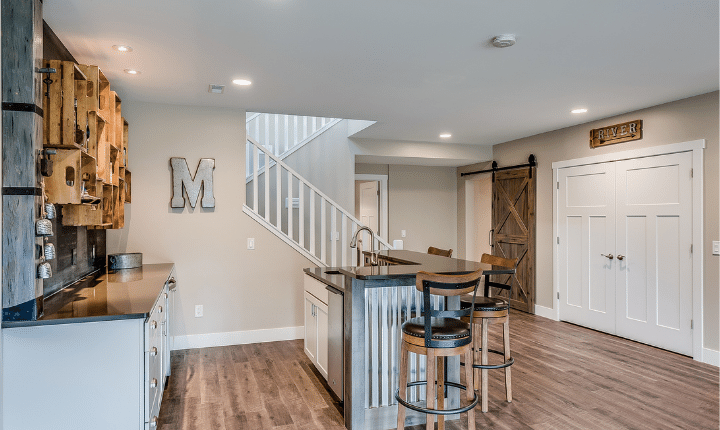How many times have you looked down your basement stairs with fear? A filthy, walled-in abyss with ghosts and darkness poised to consume you when you turn off the lone midnight light. If this sounds like something, you might understand, attempting to give your basement a facelift may be the answer. If you have an unfinished basement, renovating it may seem intimidating and pricey. But the expense and inconvenience can be worth the effort.
There’s something about basements that screams “home sweet home.” So whether you’re looking for a space to store all of your toys or to create a more relaxed living area, these 17 DIY basement ideas will have you thinking about ways to make the most of your unfinished space.
What Are Some of The Benefits of Basement Finishing Projects?
Basement finishing projects can provide several benefits, such as increased space, better insulation, and improved safety. Additionally, basement finishing projects can improve the aesthetic appeal of a home and increase its resale value. Many options are available for basement finishing projects, so it is important to choose the right one for your home. Some of the most common benefits of basement finishing projects include Increased Space: Basement finishing projects can create additional living space in a home by opening up walls and creating an extra level. This often results in more storage and easier access to the lower level. Better Insulation: Finished basements often have better insulation than unfinished basements. This is because finished basements are sealed off from the rest of the house, and any air leaks are fixed.
Why The Finish a Basement?

Basements are not just for storing tools and old equipment anymore. You can now use them as a livable space. The unfinished basement is the new trend, and there are many reasons for this. Basements can be used as an extra bedroom, office, or play area. They also provide plenty of storage space. If you want to finish your basement, keep a few things in mind. First, ensure that the space is large enough to accommodate the project. Second, make sure that it is structurally sound. Third, get help from a professional contractor if you need it. Fourth, be prepared to spend money on supplies and materials. And finally, be patient – finishing a basement can take time and effort.
What Can you Learn From These Projects?

Some people may think that starting a new project is daunting, but with the right information and tools, it can be quite simple. You can learn a lot from simply completing these three basic projects. First, take on a small project that you’re already familiar with. This will help you get your bearings and find your rhythm. Second, use online resources to get help when you need it. Plenty of tutorials and articles are available to help you along the way. And finally, don’t be afraid to ask for help from friends or family members—they’re likely more than happy to lend a hand!
Clean
Do you have an unfinished basement that’s just taking up space? You can make it clean and usable with a little effort. Here are eight steps to clean and organize your basement: 1) Evaluate the space. What needs to be done first? Is there furniture or junk that needs to be moved? 2) Clear out the clutter. Get rid of any items that are taking up space but don’t need to be used, like old magazines or newspapers. 3) Cleaning supplies. You’ll need a few things for this project: cleaners, dust cloths, buckets, mops, and brooms. 4) Sweep and vacuum. Start by sweeping the floors and collecting all the dirt and debris. Next, use a vacuum cleaner to remove any residual material. 5) Wipe down surfaces.
Declutter
Here are three easy tips to declutter and make your basement work. Start by assessing the true needs of the space. Is it a storage area, playroom, or workshop? Once you know what it’s used for, list items that need to be moved out of the space. This list should include furniture, tools, decorations, and other items not necessary for using the basement. Once you have a list of things to move out, start organizing them by category. This will help you see where everything goes and which items can stay. Once everything has been organized into categories, start sorting through the items to determine if they are needed or not.
Lighting
Basement lighting is often the last thing on homeowners’ minds when they start renovating their homes. Still, it is important to consider the effect of unfinished basement lighting on your home’s appearance. A poorly lit basement can make your home look unfinished and deter potential buyers. Here are some tips for finishing your basement and adding finishing touches to make it appear finished: -Choose the right light bulbs. A bare fluorescent bulb is all you need for basement lighting, but if you want to add more ambient light, you can use LED or CFL bulbs. -Install recessed lights or track lights. Recessed lights come in various shapes and sizes and look great in any house. They are also perfect for basements because they don’t cast shadows on walls or furniture. -Install a switch box.
Paint
Are you tired of your unfinished basement looking like a dark and dreary dungeon? If so, here is how to make it into a livable space you can be proud of. Start by painting the basement walls in light colors such as white, beige, or light blue. This will give the impression of more light and make the ceiling look higher. Next, install brighter lights to highlight different areas of the basement and put some comfortable furniture down there so people can relax after work or during family time. Finally, add a few personal touches, such as artwork or plants, to brighten the space and create an inviting atmosphere. Implementing these simple steps allows you to turn your dingy basement into your own little haven!
Sealants
There are many sealants available on the market to finish an unfinished basement. Choosing the right sealant is important to ensure the basement remains livable. The most common sealants to finish an unfinished basement include polyurethane, silicone, and epoxy. Each has its benefits and drawbacks. Polyurethane is a popular sealant because it is easy to apply and can be painted over. However, it is not as durable as other sealants and can crack if water seeps through the coating. Silicone is also popular because it is water resistant but cannot be easy to clean up after application. Epoxy is the most durable option and can last for years without deteriorating. However, it is very expensive and requires special sealing tools to apply correctly.
Space Dividers
Do you want to live in a livable space without all the clutter? Maybe you’re thinking about installing a space divider. Space dividers are a great way to create a separate space in your basement that’s both functional and stylish. Here are eight reasons you should consider installing a space divider: 1. They’re versatile. You can use them for storage, as a work area, or even as part of your home décor. 2. They’re affordable. Space dividers range in price from around $100 to $1,000, so they’re not out of reach for everyone. 3. They’re easy to install. Most space dividers contain detailed instructions and videos that walk you through installation. 4. They create privacy and separation.
Flooring
Finishing the basement is one of the most important parts of a home’s renovation. It’s a livable space and should be designed to make your life easier. Here are some key tips for finishing your basement: To make your basement functional, you’ll need flooring. Unfinished concrete or steel floors are not ideal for living in, so choose something that will last and look good. Wood is a great option, but you’ll need to be careful about moisture damage. If you’re interested in installing wood floors, consult with an expert first to ensure the job is done properly. When choosing to floor your unfinished basement, make sure it’s comfortable and easy to clean. You don’t want to spend hours mopping water up every time it rains!
Shelves
However, using the right flooring can make it into a comfortable space that you can use for storage or hanging out. Here are some key tips for choosing the right flooring for your unfinished basement: 1. Choose the type of flooring that will be compatible with the existing walls and ceiling. Avoid opting for too loud or bulky flooring, as it will only make the space feel smaller. 2. Next, consider the purpose of the room. Is it primarily a living area? A playroom? A workshop? Choose flooring that will complement these functions and look good while doing so.
Conclusion
If you’re looking for some inspiration for ideas for your unfinished basement, take a look at these 17 completed basement ideas that will inspire you to get started on your project! Whether you’re looking for a space to store all of your junk or want to create a functional home office, these basement ideas will have something for you. So go ahead and start planning your dream basement today!












Commented Posts